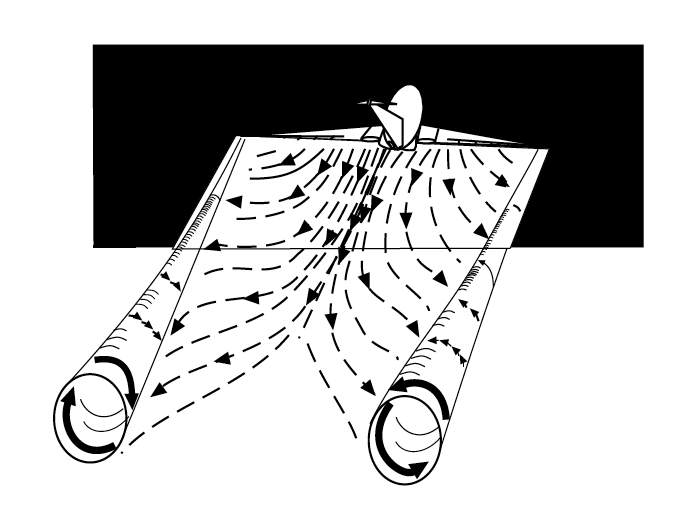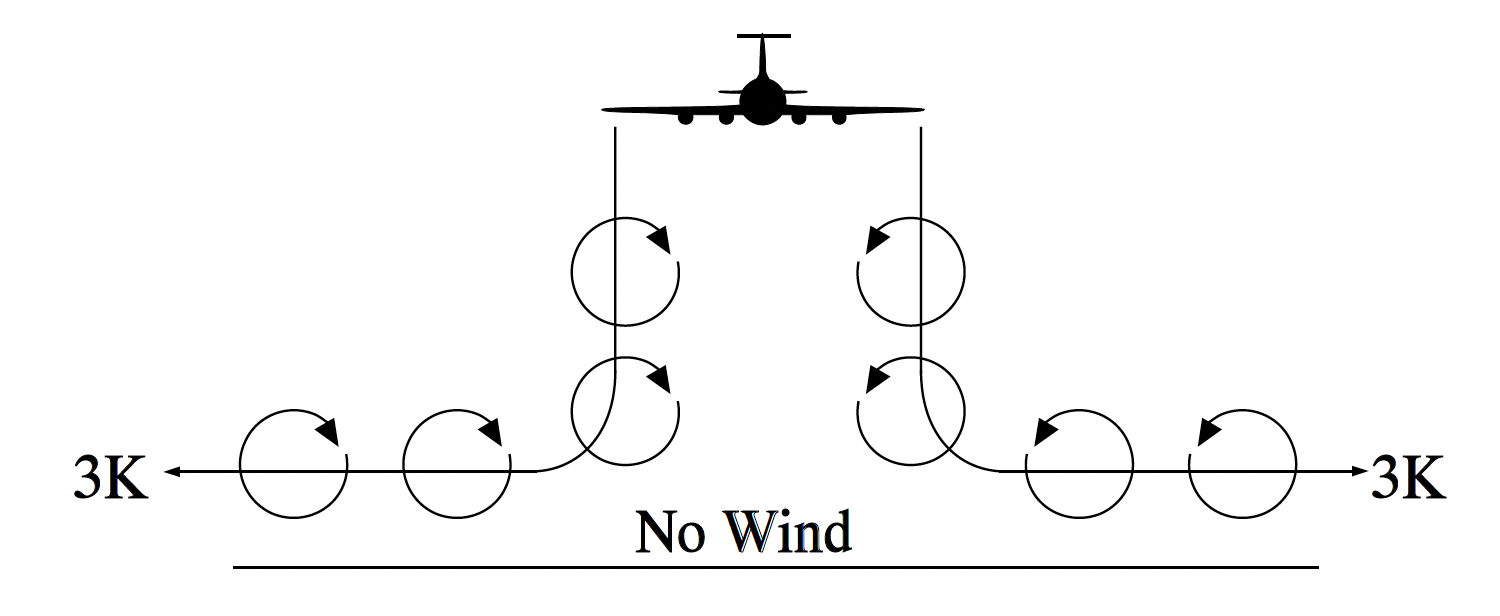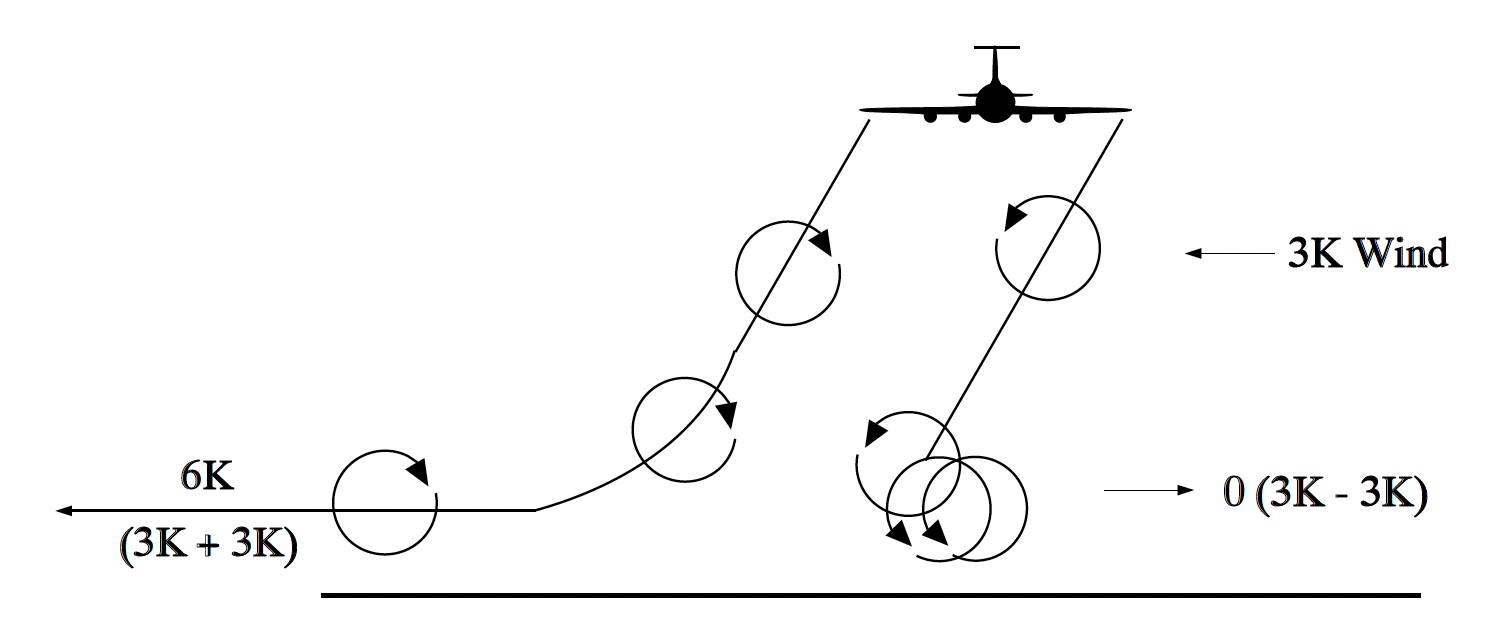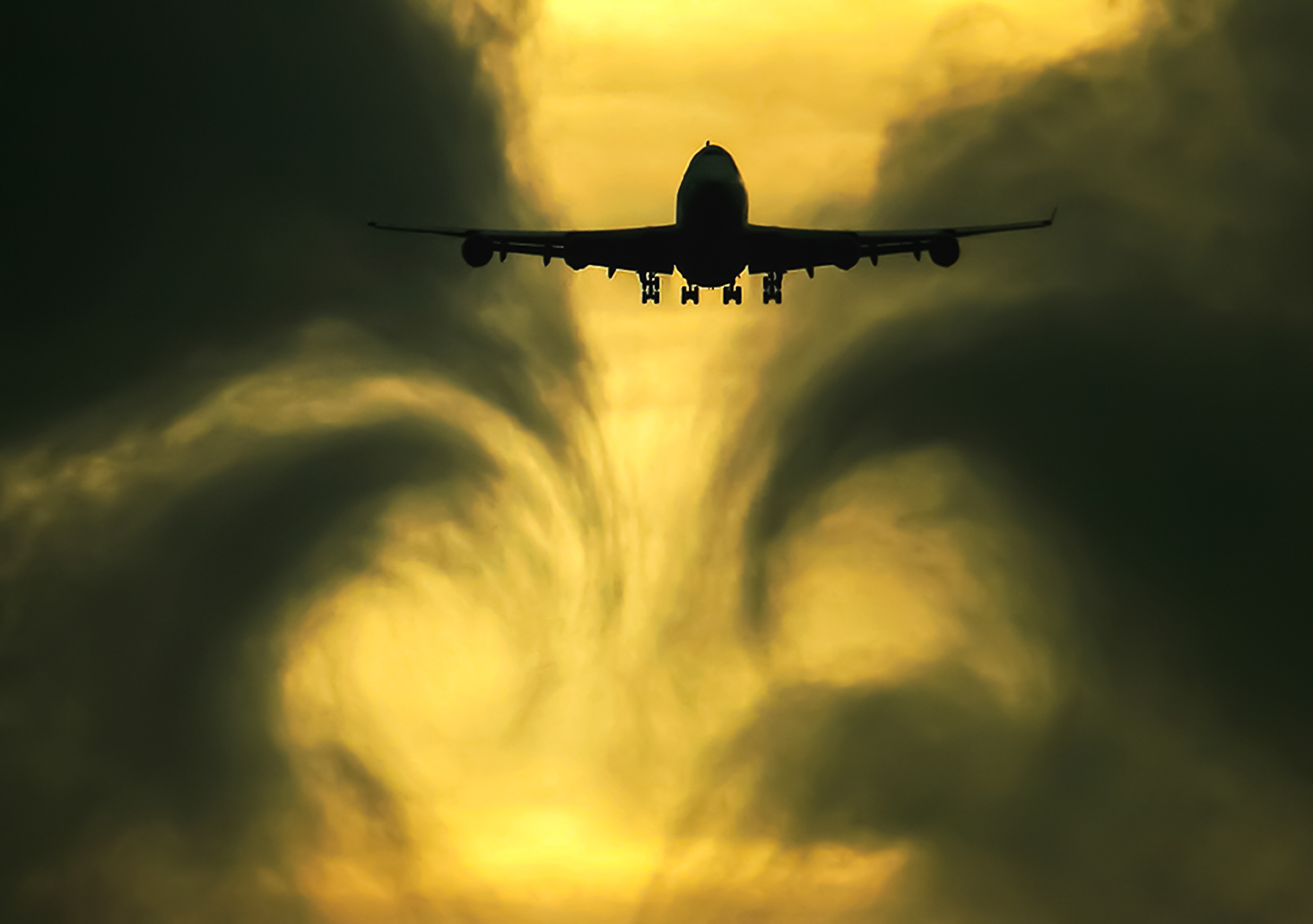"There I was, flat on my back, out of airspeed and out of ideas."
— James Albright

Updated:
2024-03-16
That almost describes what happened to me in 1981, in a 5,000 lb. T-37 getting too close to a 100,000 lb. FB-111. Even in a much larger Gulfstream, I have to worry about wake turbulence. Fortunately, ATC is getting better about keeping relatively smaller aircraft separated from relatively larger aircraft, or those that have a tendency to generate wake turbulence above their weight class. But you still have to be wary.
1 — Wake vortex characteristics
It pays to know how many minutes you need behind certain classes of aircraft before takeoff because some towers get this wrong. Unusual Attitude Recovery techniques are important, but become a bit of a challenge low to the ground. It is important to realize that you can take an otherwise flyable aircraft and break it. Case study: American Airlines 587.

1
Wake vortex characteristics
All of what follows comes from Section 7 of the AIM, which does a very good job of describing wake vortex characteristics, but perhaps understates the dangers.
Vortex generation

Wake vortex generation AIM, fig. 7-4-1
The creation of a pressure differential over the wing surface generates lift. The lowest pressure occurs over the upper wing surface and the highest pressure under the wing. This pressure differential triggers the roll up of the airflow at the rear of the wing resulting in swirling air masses trailing downstream of the wing tips. After the roll up is completed, the wake consists of two counter−rotating cylindrical vortices. (See FIG 7−4−1.) The wake vortex is formed with most of the energy concentrated within a few feet of the vortex core.
Studies have shown that winglets have a negligible effect on wake turbulence generation, particularly with the slower speeds involved during departures and arrivals.
Source: AIM, §7-4-2
Vortex generation and induced roll
Weight, speed, wingspan, and shape of the generating aircraft’s wing all govern the strength of the vortex. The vortex characteristics of any given aircraft can also be changed by extension of flaps or other wing configuring devices. However, the vortex strength from an aircraft increases proportionately to an increase in operating weight or a decrease in aircraft speed. Since the turbulence from a “dirty” aircraft configuration hastens wake decay, the greatest vortex strength occurs when the generating aircraft is HEAVY, CLEAN, and SLOW.
In rare instances, a wake encounter could cause catastrophic inflight structural damage to an aircraft. However, the usual hazard is associated with induced rolling moments that can exceed the roll−control authority of the encountering aircraft. During inflight testing, aircraft intentionally flew directly up trailing vortex cores of larger aircraft. These tests demonstrated that the ability of aircraft to counteract the roll imposed by wake vortex depends primarily on the wingspan and counter−control responsiveness of the encountering aircraft. These tests also demonstrated the difficulty of an aircraft to remain within a wake vortex. The natural tendency is for the circulation to eject aircraft from the vortex.
Counter control is usually effective and induced roll minimal in cases where the wingspan and ailerons of the encountering aircraft extend beyond the rotational flow field of the vortex. It is more difficult for aircraft with short wingspan (relative to the generating aircraft) to counter the imposed roll induced by vortex flow. Pilots of short span aircraft, even of the high performance type, must be especially alert to vortex encounters.
Source: AIM, §7-4-3
Two comments about the AIM's assertions here. First, while it might be technically true the natural tendency is for wake vortices to eject aircraft from the vortex, that does you little good if your aircraft is damaged to the point it is no longer flyable. See Case Study: American Airlines 587. Second, saying counter control is usually effective and induced roll is minimal when your wingspan extends beyond to vortex is pointless, since you have no idea where that vortex is unless you are flying behind a smoke trail of a test aircraft.
Vortex behavior: after takeoff rotation and before landing

Wake ends / wake begins, AIM, fig. 7-4-3
An aircraft generates vortices from the moment it rotates on takeoff to touchdown, since trailing vortices are a by−product of wing lift. Prior to takeoff or touchdown pilots should note the rotation or touchdown point of the preceding aircraft.
Source: AIM, §7-4-4.a.2.
During takeoff, if you are certain you can takeoff before the preceding aircraft's rotation point and can out-climb that aircraft, you will probably avoid its wake. Be advised, however, that that aircraft begins to generate vortices when the wing starts to generate lift, which could happen before the rotation point. A gentle crosswind could put one of the vortices right over the runway.
Vortex behavior: At altitude

Vortex flow field, AIM, fig. 7-4-4
Flight tests have shown that the vortices from larger aircraft sink at a rate of several hundred feet per minute, slowing their descent and diminishing in strength with time and distance behind the generating aircraft. Pilots should fly at or above the preceding aircraft’s flight path, altering course as necessary to avoid the area directly behind and below the generating aircraft. Pilots, in all phases of flight, must remain vigilant of possible wake effects created by other aircraft. Studies have shown that atmospheric turbulence hastens wake breakup, while other atmospheric conditions can transport wake horizontally and vertically.
Source: AIM, §7-4-4.a.3.
I'm not sure what they mean by "nominally 500-1000 ft." in the diagram, since the word nominally in this context means "theoretically." Theory is sparse on the subject and a 2003 study showed that vortices can descend more than 1,000 feet. See the Case Study: Challenger 604 D-AMSC.
Vortex behavior: Movement near the ground - no wind

Vortex movement near ground - no wind AIM, fig. 7-4-5
When the vortices of larger aircraft sink close to the ground (within 100 to 200 feet), they tend to move laterally over the ground at a speed of 2 or 3 knots.
Pilots should be alert at all times for possible wake vortex encounters when conducting approach and landing operations. The pilot is ultimately responsible for maintaining an appropriate interval, and should consider all available information in positioning the aircraft in the terminal area, to avoid the wake turbulence created by a preceding aircraft. Test data shows that vortices can rise with the air mass in which they are embedded. The effects of wind shear can cause vortex flow field “tilting.” In addition, ambient thermal lifting and orographic effects (rising terrain or tree lines) can cause a vortex flow field to rise and possibly bounce.
Source: AIM, §7-4-4.a.4. and 5.
The "2 or 3 knots" was once published at a firm 5 knots and we used to routinely discount the impact of vortices if the crosswind was greater than 5 knots. This didn't always work. If you throw in all the other variables of the air mass other than wind, I think you should conclude that vortex behavior isn't as predictable as some would have you believe.
Vortex behavior: Movement near the ground - with crosswinds

Vortex movement near ground - with crosswinds AIM, fig. 7-4-6
A crosswind will decrease the lateral movement of the upwind vortex and increase the movement of the downwind vortex. Thus, a light wind with a cross−runway component of 1 to 5 knots could result in the upwind vortex remaining in the touchdown zone for a period of time and hasten the drift of the downwind vortex toward another runway. Similarly, a tailwind condition can move the vortices of the preceding aircraft forward into the touchdown zone. THE LIGHT QUARTERING TAILWIND REQUIRES MAXIMUM CAUTION. Pilots should be alert to large aircraft upwind from their approach and takeoff flight paths.
Source: AIM, §7-4-4.a.6.
2
Categories and groups
Note.— The term “wake turbulence” is used in this context to describe the effect of the rotating air masses generated behind the wing tips of large jet aircraft, in preference to the term “wake vortex” which describes the nature of the air masses. Detailed characteristics of wake vortices and their effect on aircraft are contained in the Air Traffic Services Planning Manual (Doc 9426), Part II, Section 5.
4.9.1 Wake turbulence categories and groups of aircraft
4.9.1.1 Except as provided for in 4.9.1.2, wake turbulence separation minima shall be based on a grouping of aircraft types into four categories according to the maximum certificated take-off mass as follows:
a) SUPER (J) — aircraft types specified as such in ICAO Doc 8643, Aircraft Type Designators;
b) HEAVY (H) — all aircraft types of 136 000 kg or more, with the exception of aircraft types listed in Doc 8643 in the SUPER (J) category;
c) MEDIUM (M) — aircraft types less than 136 000 kg but more than 7 000 kg; and
d) LIGHT (L) — aircraft types of 7 000 kg or less.
Note.— The wake turbulence category for each aircraft type is contained in Doc 8643, Aircraft Type Designators.
4.9.1.2 When approved by the appropriate ATS authority, wake turbulence separation minima may be applied utilizing wake turbulence groups and shall be based on wake generation and resistance characteristics of the aircraft. These depend primarily on maximum certificated take-off mass, wing characteristics and speeds; the group designators are described as follows:
a) GROUP A — aircraft types of 136 000 kg or more, and a wing span less than or equal to 80 m but greater than 74.68 m;
b) GROUP B — aircraft types of 136 000 kg or more, and a wing span less than or equal to 74.68 m but greater than 53.34 m;
c) GROUP C — aircraft types of 136 000 kg or more, and a wing span less than or equal to 53.34 m but greater than 38.1 m;
d) GROUP D — aircraft types less than 136 000 kg but more than 18 600 kg, and a wing span greater than 32 m;
e) GROUP E — aircraft types less than 136 000 kg but more than 18 600 kg, and a wing span less than or equal to 32 m but greater than 27.43 m;
f) GROUP F — aircraft types less than 136 000 kg but more than 18 600 kg, and a wing span less than or equal to 27.43 m;
g) GROUP G — aircraft types of 18 600 kg or less (without wing span criterion).
Note 1. — Information on the wake turbulence group for each aircraft type is contained in Doc 8643 Aircraft Type Designators. Note 2. — Guidance on the implementation of wake turbulence separation between wake turbulence groups can be found in the Manual on Implementation of Wake Turbulence Separation Minima (Doc 10122).
4.9.1.2.1 Essential information, including the wake turbulence group designator as necessary, shall be provided to the controller when separation based on wake turbulence groups is to be applied.
4.9.1.3 Helicopters should be kept well clear of light aircraft when hovering or while air taxiing.
Note 1.— Helicopters produce vortices when in flight and there is some evidence that, per kilogram of gross mass, their vortices are more intense than those of fixed-wing aircraft. When hovering in ground effect or air taxiing, helicopters generate downwash producing high velocity outwash vortices to a distance approximately three times the diameter of the rotor.
Note 2.— The provisions governing wake turbulence separation minima are set forth in Chapter 5, Section 5.8, and Chapter 8, Section 8.7.3.
4.9.2 Indication of super or heavy wake turbulence category
For aircraft in the SUPER or HEAVY wake turbulence categories the word “super” or “heavy” shall be included, as appropriate, immediately after the aircraft call sign in the initial radiotelephony contact between such aircraft and ATS units.
Note 1.— Wake turbulence categories are specified in the instructions for completing Item 9 of the flight plan in Appendix 2.
Note 2.— Wake turbulence Group A is equivalent to the SUPER wake turbulence category, and Groups B and C are equivalent to the HEAVY category.
Source: ICAO Doc 4444, ¶4.9
3
Separation Rules
Time-based separation
5.8.1.1 The ATC unit concerned shall not be required to apply wake turbulence separation:
a) for arriving VFR flights landing on the same runway as a preceding landing SUPER, HEAVY or MEDIUM aircraft; and
b) between arriving IFR flights executing visual approach when the aircraft has reported the preceding aircraft in sight and has been instructed to follow and maintain own separation from that aircraft.
5.8.1.2 The ATC unit shall, in respect of the flights specified in 5.8.1.1 a) and b), as well as when otherwise deemed necessary, issue a caution of possible wake turbulence. The pilot-in-command of the aircraft concerned shall be responsible for ensuring that the spacing from a preceding aircraft of a heavier wake turbulence category is acceptable. If it is determined that additional spacing is required, the flight crew shall inform the ATC unit accordingly, stating their requirements.
Source: ICAO Doc 4444, ¶5.8.1, Applicability
5.8.2.1 Except as provided for in 5.8.1.1 a) and b), the following minima shall be applied to aircraft landing behind a SUPER, a HEAVY or a MEDIUM aircraft:
a) HEAVY aircraft landing behind SUPER aircraft — 2 minutes;
b) MEDIUM aircraft landing behind SUPER aircraft — 3 minutes;
c) MEDIUM aircraft landing behind HEAVY aircraft — 2 minutes;
d) LIGHT aircraft landing behind SUPER aircraft — 4 minutes;
e) LIGHT aircraft landing behind a HEAVY or MEDIUM aircraft — 3 minutes.
Source: ICAO Doc 4444, ¶5.8.2,] Arriving aircraft
5.8.3.1 When using wake turbulence categories contained in Chapter 4, 4.9.1.1 and when the aircraft are using:
a) the same runway;
b) parallel runways separated by less than 760 m (2 500 ft);
c) crossing runways if the projected flight path of the second aircraft will cross the projected flight path of the first aircraft at the same altitude or less than 300 m (1 000 ft) below;
d) parallel runways separated by 760 m (2 500 ft) or more, if the projected flight path of the second aircraft will cross the projected flight path of the first aircraft at the same altitude or less than 300 m (1 000 ft) below.
the following minimum separations shall be applied
1) HEAVY aircraft taking off behind a SUPER aircraft — 2 minutes;
2) LIGHT or MEDIUM aircraft taking off behind a SUPER aircraft — 3 minutes;
3) LIGHT or MEDIUM aircraft taking off behind a HEAVY aircraft — 2 minutes;
4) LIGHT aircraft taking off behind a MEDIUM aircraft — 2 minutes.
Source: ICAO Doc 4444, ¶5.8.3, Departing aircraft
ATS surveillance separation
The aviation world is still regrouping after the wake turbulence upset of a Challenger 604 in 2017 — see Case Study: Challenger 604 D-AMCS. As I write this, the latest version of the Aeronautical Information Manual still promises: "The FAA and ICAO are leading initiatives, in terminal environments, to implement next−generation wake turbulence procedures and separation standards." (AIM, §7-1-10.) Even seven years after the proof that existing wake turbulence separation standards were insufficient, we are still playing with it. The message to us is clear: be cautious and give the A380 a wide berth.
FAA Rules
Separation is applied to aircraft operating directly behind a super or heavy at the same altitude or less than 1,000 feet below, and to small aircraft operating directly behind a B757 at the same altitude or less than 500 feet below:
(a) Heavy behind super − 6 miles.
(b) Large behind super − 7 miles.
(c) Small behind super − 8 miles.
(d) Heavy behind heavy −4 miles.
(e) Small/large behind heavy − 5 miles.
(f) Small behind B757 − 4 miles.
Source: AIM, §7-4-9.a.1.
ICAO Rules
8.7.3.1 Unless otherwise prescribed in accordance with 8.7.3.2, 8.7.3.3 or 8.7.3.4, or Chapter 6 (with respect to independent and dependent parallel approaches), the horizontal separation minimum based on radar and/or ADS-B and/or MLAT systems shall be 9.3 km (5.0 NM).
8.7.3.2 The separation minimum in 8.7.3.1 may, if so prescribed by the appropriate ATS authority, be reduced, but not below:
a) 5.6 km (3.0 NM) when radar and/or ADS-B and/or MLAT systems’ capabilities at a given location so permit; and
b) 4.6 km (2.5 NM) between succeeding aircraft which are established on the same final approach track within 18.5 km (10 NM) of the runway threshold. A reduced separation minimum of 4.6 km (2.5 NM) may be applied, provided:
i) the average runway occupancy time of landing aircraft is proven, by means such as data collection and statistical analysis and methods based on a theoretical model, not to exceed 50 seconds;
ii) braking action is reported as good and runway occupancy times are not adversely affected by runway contaminants such as slush, snow or ice;
iii) an ATS surveillance system with appropriate azimuth and range resolution and an update rate of 5 seconds or less is used in combination with suitable displays;
iv) the aerodrome controller is able to observe, visually or by means of surface movement radar (SMR), MLAT system or a surface movement guidance and control system (SMGCS), the runway-in-use and associated exit and entry taxiways;
v) distance-based wake turbulence separation minima in 8.7.3.4, or as may be prescribed by the appropriate ATS authority (e.g. for specific aircraft types), do not apply;
vi) aircraft approach speeds are closely monitored by the controller and when necessary adjusted so as to ensure that separation is not reduced below the minimum;
vii) aircraft operators and pilots have been made fully aware of the need to exit the runway in an expeditious manner whenever the reduced separation minimum on final approach is applied; and
viii) procedures concerning the application of the reduced minimum are published in AIPs.
8.7.3.3 The separation minimum or minima based on radar and/or ADS-B and/or MLAT systems to be applied shall be prescribed by the appropriate ATS authority according to the capability of the particular ATS surveillance system or sensor to accurately identify the aircraft position in relation to the centre of a position symbol, PSR blip, SSR response and taking into account factors which may affect the accuracy of the ATS surveillance system-derived information, such as aircraft range from the radar site and the range scale of the situation display in use.
8.7.3.4 When using wake turbulence categories contained in Chapter 4, 4.9.1.1, the following distance-based wake turbulence separation minima shall be applied to aircraft being provided with an ATS surveillance service in the approach and departure phases of flight in the circumstances given in 8.7.3.4.1.
| Aircraft category | |||
| Preceding aircraft | Succeeding aircraft | Distance-based wake turbulence separation minima | |
| SUPER | HEAVY | 9.3 km (5.0 NM) | |
| MEDIUM | 13.0 km (7.0 NM) | ||
| LIGHT | 14.9 km (8.0 NM) | ||
| HEAVY | HEAVY | 7.4 km (4.0 NM) | |
| MEDIUM | 9.3 km (5.0 NM) | ||
| LIGHT | 11.1 km (6.0 NM) | ||
| MEDIUM | LIGHT | 9.3 km (5.0 NM) | |
8.7.3.6 The minima set out in 8.7.3.4 shall be applied when:
a) an aircraft is operating directly behind another aircraft at the same altitude or less than 300 m (1 000 ft) below; or
b) both aircraft are using the same runway or parallel runways separated by less than 760 m (2 500 ft); or
c) an aircraft is crossing behind another aircraft at the same altitude or less than 300 m (1 000 ft) below.
Source: ICAO Doc 4444, ¶8.7.3, Separation minima based on ATS surveillance systems
4
Avoidance techniques
We still don't have wake turbulence figured out, as evidenced by the near loss of Challenger 604 D-AMSC in 2017. It became clear that we as an industry certified the Airbus A380 for heavy wake turbulence, not realizing its wake was even worse. Studies before that mishap revealed the wake of heavy aircraft can extend below 1,000 feet, and yet the only reaction has been to call for more study:
Based on extensive analysis of wake vortex behavior, new procedures and separation standards are being developed and implemented in the US and throughout the world. Wake research involves the wake generating aircraft as well as the wake toleration of the trailing aircraft.
Source: AIM, §7-4-10
We as pilots are left to our own wits to be extra cautions.
AIM techniques
The following vortex avoidance procedures are recommended for the various situations:
- Landing behind a larger aircraft− same runway. Stay at or above the larger aircraft’s final approach flight path−note its touchdown point−land beyond it.
- Landing behind a larger aircraft− when parallel runway is closer than 2,500 feet. Consider possible drift to your runway. Stay at or above the larger aircraft’s final approach flight path− note its touchdown point.
- Landing behind a larger aircraft− crossing runway. Cross above the larger aircraft’s flight path.
- Landing behind a departing larger aircraft− same runway. Note the larger aircraft’s rotation point−land well prior to rotation point.
- Landing behind a departing larger aircraft− crossing runway. Note the larger aircraft’s rotation point− if past the intersection− continue the approach− land prior to the intersection. If larger aircraft rotates prior to the intersection, avoid flight below the larger aircraft’s flight path. Abandon the approach unless a landing is ensured well before reaching the intersection.
- Departing behind a larger aircraft. Note the larger aircraft’s rotation point and rotate prior to the larger aircraft’s rotation point. Continue climbing above the larger aircraft’s climb path until turning clear of the larger aircraft’s wake. Avoid subsequent headings which will cross below and behind a larger aircraft. Be alert for any critical takeoff situation which could lead to a vortex encounter.
- Intersection takeoffs− same runway. Be alert to adjacent larger aircraft operations, particularly upwind of your runway. If intersection takeoff clearance is received, avoid subsequent heading which will cross below a larger aircraft’s path.
- Departing or landing after a larger aircraft executing a low approach, missed approach, or touch−and−go landing. Because vortices settle and move laterally near the ground, the vortex hazard may exist along the runway and in your flight path after a larger aircraft has executed a low approach, missed approach, or a touch−and−go landing, particular in light quartering wind conditions. You should ensure that an interval of at least 2 minutes has elapsed before your takeoff or landing.
- En route VFR (thousand−foot altitude plus 500 feet). Avoid flight below and behind a large aircraft’s path. If a larger aircraft is observed above on the same track (meeting or overtaking) adjust your position laterally, preferably upwind.
Source: AIM, §7-4-6.b.
A few more techniques to consider
Your best defense against getting a wake turbulence surprise is situational awareness. During descent on a STAR, for example, it would be wise maintain a flight path above larger aircraft in front of you. ADS-B In provides a great tool for this. If spacing becomes tight, you could ask ATC for a 2 nm offset upwind of the aircraft. You should also consider staying above or upwind of traffic ahead of you on approach. Finally, keep a watch for aircraft in the Super category and try to envision where they are in relation to your flight path. When departing Boston for Europe, for example, hearing there is a Super flying parallel to us, we become wary of any headings that converge until we are above the threatening aircraft.
References
(Source material)
Aeronautical Information Manual, 4/20/23
ICAO Doc 4444, Amendment 9 to the PANS-ATM, 15 June 2020
